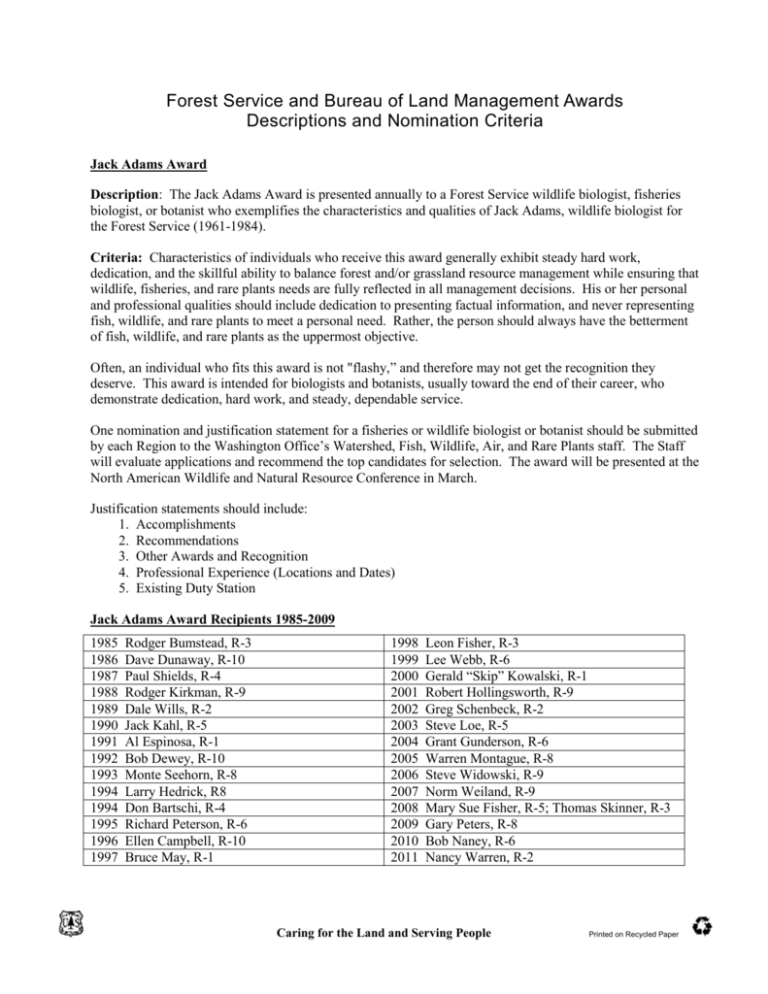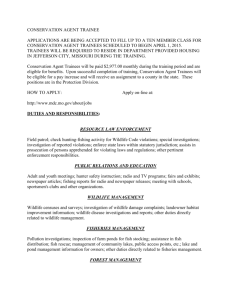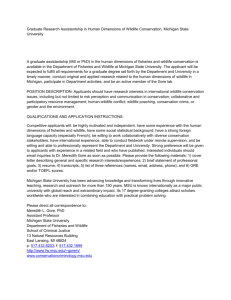Forest Service and Bureau of Land Management Awards
advertisement

Forest Service and Bureau of Land Management Awards Descriptions and Nomination Criteria Jack Adams Award Description: The Jack Adams Award is presented annually to a Forest Service wildlife biologist, fisheries biologist, or botanist who exemplifies the characteristics and qualities of Jack Adams, wildlife biologist for the Forest Service (1961-1984). Criteria: Characteristics of individuals who receive this award generally exhibit steady hard work, dedication, and the skillful ability to balance forest and/or grassland resource management while ensuring that wildlife, fisheries, and rare plants needs are fully reflected in all management decisions. His or her personal and professional qualities should include dedication to presenting factual information, and never representing fish, wildlife, and rare plants to meet a personal need. Rather, the person should always have the betterment of fish, wildlife, and rare plants as the uppermost objective. Often, an individual who fits this award is not "flashy,” and therefore may not get the recognition they deserve. This award is intended for biologists and botanists, usually toward the end of their career, who demonstrate dedication, hard work, and steady, dependable service. One nomination and justification statement for a fisheries or wildlife biologist or botanist should be submitted by each Region to the Washington Office’s Watershed, Fish, Wildlife, Air, and Rare Plants staff. The Staff will evaluate applications and recommend the top candidates for selection. The award will be presented at the North American Wildlife and Natural Resource Conference in March. Justification statements should include: 1. Accomplishments 2. Recommendations 3. Other Awards and Recognition 4. Professional Experience (Locations and Dates) 5. Existing Duty Station Jack Adams Award Recipients 1985-2009 1985 1986 1987 1988 1989 1990 1991 1992 1993 1994 1994 1995 1996 1997 Rodger Bumstead, R-3 Dave Dunaway, R-10 Paul Shields, R-4 Rodger Kirkman, R-9 Dale Wills, R-2 Jack Kahl, R-5 Al Espinosa, R-1 Bob Dewey, R-10 Monte Seehorn, R-8 Larry Hedrick, R8 Don Bartschi, R-4 Richard Peterson, R-6 Ellen Campbell, R-10 Bruce May, R-1 1998 1999 2000 2001 2002 2003 2004 2005 2006 2007 2008 2009 2010 2011 Leon Fisher, R-3 Lee Webb, R-6 Gerald “Skip” Kowalski, R-1 Robert Hollingsworth, R-9 Greg Schenbeck, R-2 Steve Loe, R-5 Grant Gunderson, R-6 Warren Montague, R-8 Steve Widowski, R-9 Norm Weiland, R-9 Mary Sue Fisher, R-5; Thomas Skinner, R-3 Gary Peters, R-8 Bob Naney, R-6 Nancy Warren, R-2 Caring for the Land and Serving People Printed on Recycled Paper Jack Adams Jack Adams was born and grew up in Utah. He attended Utah State University, and received a Bachelor's Degree in wildlife management in the early 1960's. He immediately went to work for the Utah Division of Wildlife Resources. After a few years he transferred to the Cache National Forest as a wildlife biologist and to the Dixie National Forest as a District Ranger. In the early 1970's he transferred to the Apache-Sitgreaves NF as a wildlife biologist. While on that Forest he was recognized by the Arizona-New Mexico Section of The Wildlife Society as “Outstanding Wildlifer” of the year. He transferred to the Regional Office in Albuquerque in the mid-1970's as their wildlife program manager. After a short time in Albuquerque, he was reassigned to Ogden to oversee planning and the budget in the Fish and Wildlife staff. During Jack's stay in Ogden, he was being seriously considered for a Forest Supervisor position. This would have been unique, for at that time there were few line officers at the Supervisor and higher levels from the biologist series. In 1982 or early 1983, Jack was diagnosed with a malignant brain tumor. He underwent surgery and various treatments and fought a noble battle, succumbing to cancer in early 1984 at the height of his career. Following his death, the Washington Office and the Intermountain Region decided to recognize the biologist or botanist that best reflect the unique qualities of Jack Adams. Those qualities include a strong passion for proper stewardship of the National Forests and fish and wildlife resources, strong relationships with the States and other partners, a bias for getting the job done on the ground, a concern for people, and never using one’s position to bring attention to yourself or for personal gain. The award was first presented in 1984 and has been presented every year since. It has usually been presented to the individual that exemplifies these qualities, has not gotten much recognition, and is nearing the end of their career. In other words those individuals that have been dependable, steady producers throughout their careers but have not received much formal recognition. 2 Lloyd W. Swift Sr. Award Description: This award is presented periodically to a current or past Forest Service employee in the field of wildlife, fisheries, and rare plants who exemplifies the characteristics, accomplishments, and qualities of Lloyd W. Swift Sr., a wildlife biologist for the Forest Service (1928-1963). As part of his long and illustrious career with the Forest Service, Lloyd served as the National Wildlife and Fisheries Director from 1944 through 1963. Criteria: Nominees for this award must have demonstrated a lifetime of dedication, commitment, and leadership in management of the wildlife and fisheries resources of the United States. The career of the nominees should include examples of leadership that have contributed substantially to fisheries and wildlife conservation on national forests and grasslands. The nominee's personal and professional qualities should include dedication and demonstrated commitment to develop and work with internal and external partners to understand, sustain, and enhance wildlife and fisheries resources in a collaborative manner. The award will recognize individuals holding or who have held positions with significant fish, wildlife, and rare plants management responsibilities at the Regional or Washington Office level. The award will usually be presented toward the end of an individual's career or after retirement. Opportunities for Regional Foresters to nominate candidates for this award will be announced on a periodic basis. Application packages should include: 1. Title 2. Current Position or Address 3. Summary of Career Achievements 4. Justification Statements, including: a. Professional Experience and Recognition b. Professional Accomplishments with specific examples. The committee selection process for this award will be conducted by the WFWARP Director, the Deputy Chief for National Forest Systems. The award will be presented at the North American Wildlife and Natural Resource Conference in late March. Lloyd W. Swift Sr. Award Recipients (1998-2007) 1998 1999 2000 2001 2002 2003 2004 2005 2006 Lloyd W. Swift Sr. Bob Nelson (no award made) Phil Janik Paul Brouha Jerry McIlwain Jack Capp Dave Gibbons Richard Holthausen 2007 2008 2009 2010 2011 Tom L. Darden James J. Claar David Heller Marc Bosch Don DeLorenzo 3 Lloyd W. Swift Sr. Lloyd W. Swift Sr. was born September 4, 1904, on the Swift Ranch near Ione, Amador County, California. Mr. Swift is the youngest of five children and spent most of his childhood on his family's cattle ranch where he attended a one-room school house and spent summers with relatives in the Georgetown Divide portion of the Sierra Nevada Mountains. Lloyd pursued his academic career initially at the University of California at Davis, enrolling in 1922 in its first 4-year class. After 3 years at UC Davis, he transferred to the University of California, Berkeley, and pursued a course in range science in the Department of Forestry. Although he claims allegiance to both UC Davis and Berkeley, his B.S. (1927) and his M.S. (1930) degrees are from Berkeley. He worked for the USDA Forest Service in seasonal positions during his college career, and received a Junior Range Examiner appointment in 1928 on the Lassen N.F. From 1930-1932, Lloyd was chief of party for the range survey on the Plumas N.F., and continued serving on the Plumas National Forest as Range and Wildlife Staff Assistant. During this period, he also served on two details to the WO and worked with western regional representatives preparing the Range Plant Handbook published in 1937. He also served in the San Francisco Regional Office and at the California Forest Range and Experiment Station at Berkeley. After a transfer to the Rocky Mountain Regional Office in Denver, Colorado, Lloyd served as the Regional Wildlife Staff from 1939 through 1941. Lloyd transferred to the Washington DC headquarters in 1942 as assistant to Dr. Homer Shantz in the Division of Wildlife Management. In 1944, he became the Director. Under his leadership the agency was constantly reminded of the need to broaden the Forest Service focus to include habitat improvement for fish, upland game birds, furbearers, and vanishing species. He emphasized the coordination of wildlife needs with other uses. He worked closely with State wildlife and fish directors to ensure cooperation in wildlife and fish habitat management. Throughout his career he kept in touch and worked with many associates in other agencies and organizations. In 1951, Lloyd initiated a general revision of the Forest Service Wildlife Manual. His idea was for each national forest to develop a "Limited Wildlife Management Plan" outlining how wildlife needs would be coordinated with other uses on the forest. The wildlife plans were eventually subsumed in the multiple-use land management plans for each forest. Lloyd retired in 1963, ending a 35-year career. From 1963 to 1966, Lloyd was the first executive officer of the U.S. Appeal of the World Wildlife Fund. He is a member of the Cosmos Club, having served as President in 1978, the centennial year of the club. He was President of the Washington Field Biologist Club from 1956 to 1959, and is an honorary member of the Natural Resources Council of America. Lloyd is member of the Boone and Crockett Club and other conservation and technical organizations. As a consulting biologist, Lloyd has served in Africa and the Middle East with organizations such as U.S. AID, the Food and Agricultural Organization, UNESCO, the United Nation's Special Fund, and various assignments in the United States. While graduate students in 1929, Lloyd married Clara Bishop, the great-granddaughter of James Hall, the famous geologist and paleontologist from New York State. They were the parents of two children, Lloyd Jr. and Clara. Lloyd Jr. graduated from Duke University and Clara is a graduate of Oberlin College. Lloyd had 6 grandchildren and 5 great-grandchildren. His wife Clara passed away in 1964. Lloyd remarried in 1969 to Rose Ward Dieter, who worked for the Wildlife Management Institute, and they resided in Falls Church, Virginia until Lloyd’s passing on February 20, 2001. Lloyd Swift was 96. 4 FS-BLM Conservation Project Award Description/Criteria: This award is presented annually to recognize development and implementation of a joint FS-BLM project with outstanding conservation accomplishments for fish, wildlife and/or native plants and their habitat on public lands, and/or facilitates their use, enjoyment or appreciation. The project can be at either a local, Regional, or national level. Emphasis will be given to projects that have demonstrated, through the FS-BLM partnership, unique or innovative approaches that promotes public understanding of cooperative conservation; work at a watershed or regional scale, are multi-year and scope, involve creative or multiple partnerships; have high conservation value, and meet FS and BLM priorities. Nomination package should include: 1. Name and location of project 2. Title and contact points of key FS and BLM personnel responsible for project 3. Contact points of nominators 4. Summary of project accomplishment and significance for wildlife, fish, and/or native plants and their habitats. 5. Description of how the project strengthened interagency coordination and provides an example of interagency collaboration to benefit species and habitats. FS-BLM Conservation Project Award Recipients 2001 Interagency Lynx Biology Team 2002 Upper Salmon Basin Watershed Project 2003 Washington Rare Plant Care and Conservation 2004 Western Snowy Plover Working Team 2004 Interagency Conservation Strategy Team for the Grizzly Bear (Greater Yellowstone Area) 2005 Whiskey Mountain Technical Committee 2006 Upper Rio Grande Cutthroat Conservation Project 2007 Federal Partners in Rare Plant Species Management – Capitol Reef National Monument, Fishlake National Forest, and the BLM Richfield Field Office, south central Utah. 2008 West-slope Bighorn Mountains Cooperative Initiative 2009 Oak Ridge/Lost Park Coordinated Resource Management Plan and the Interagency Special Status/Sensitive Species Program Team 2010 East Magdalena Landscape Project 2011 Great Basin Native Plant Selection and Increase Project 5 FS-BLM Conservation Leadership Partner Award Description/Criteria: This award is presented annually to an organization or individual representing a conservation organization for their outstanding leadership in the development and implementation of conservation programs and activities that have directly benefited fish, wildlife, and/or native plants on public lands or their use, enjoyment, and appreciation. Nominees of this award must have demonstrated sustained dedication, leadership, and commitment to work collaboratively to build partnerships that promote sound land management practices and the conservation of wildlife, fisheries and/or native plant resources that depend on public lands. Nominee accomplishments can be at either a local, regional, or national level. Emphasis will be given to nominees who: have a long-standing partnership (four or more years) with the BLM and the Forest Service; have a demonstrated track record of cooperative conservation success; are recognized leaders in the conservation field; use unique or innovative approaches; and/or work to promote public understanding of cooperative conservation. Nomination package should include: 1. Title of person and/or organization for which they work 2. Current Position or Address 3. Contact points of nominators 4. Summary of Achievements. 5. Other information that you feel is appropriate for consideration. FS-BLM Conservation Leadership Partner Award Recipients 2001 Point Reyes Bird Observatory 2002 Desert Tortoise Preserve Committee 2003 Upper Snake River Conservation Team 2004 Rocky Mountain Elk Foundation 2005 Quail Unlimited 2006 Aspen Delineation Project, David Burton 2007 National Wild Turkey Federation 2008 Bat Conservation International 2009 The Nature Conservancy 2010 Salmon Valley Stewardship 2011 The Mule Deer Foundation 6






